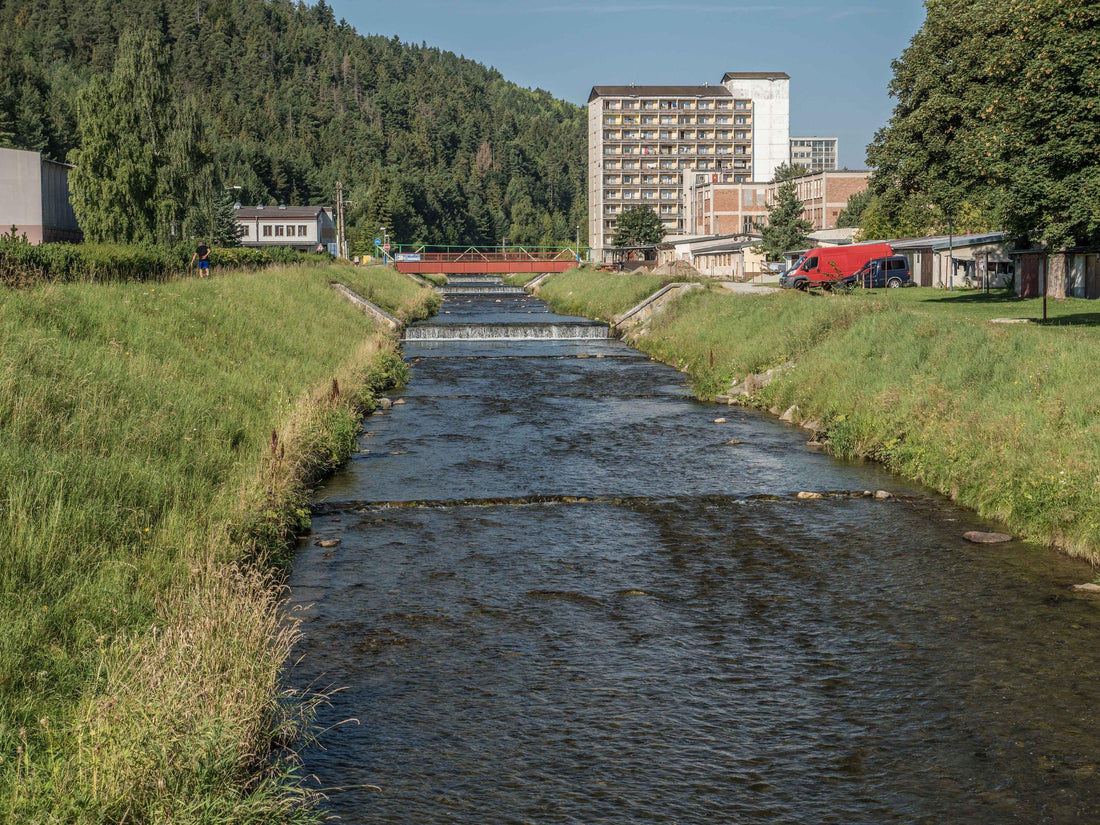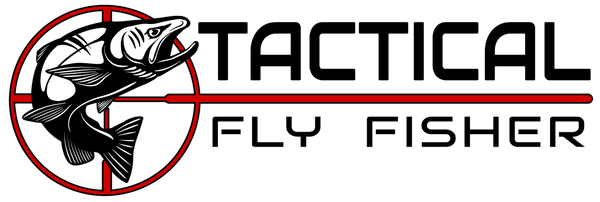
2017 World Fly Fishing Championships in Slovakia: Session three on the Poprad River
Share
In my 3rd session during this year’s World Fly Fishing Championship I fished the Poprad River, which was one of the two smaller rivers in the championship. The Poprad is one of the sadder examples of man’s effect on river form and function that I’ve seen. The river runs through several industrial towns and (I assume during the time of the Soviet Union) it was put in a cobbled dike through each of the towns it runs through. I could describe the ill effects that such practices have on a river based on watershed science and fluvial geomorphology, but that’s for another time. Needless to say, the river was anything but natural (as were the fish) and the venue changed fairly drastically in water type and fish abundance and composition from the top to the bottom of the venue.

A weir pool in the upper beats.

An example of the shallow water between weirs in the town beats.
The top beats were located in a town and were typified by straight shallow channels occasionally dropping into large weir pools. These beats were dominated by small stocked browns with some big stocked rainbows in the weir pools. The lower beats were downstream of town and were managed by a different angling club. They featured mostly grayling with a few trout. As you might expect, the beats in between were a mix of both trout and grayling.
I drew beat 28 near the bottom of the venue where grayling were the dominant fish. My teammates who had fished the Poprad in the first two sessions had drawn beats in the upper part of the river so I wasn’t sure how their experiences would translate to my beat on the lower river. My beat had one deep pool in the bottom third below some artificially placed boulders. This was the only part of the beat that had much depth. As a result, I fished from my knees for about 2.5 of the 3 hours in the session to keep my profile low and avoid spooking fish. Upstream there was a shallow run and riffle and the top of the beat was a long shallow and smooth glide which trailed from a deeper run in the beat above.

The shaded riffle where I started my session and caught a good share of my fish.

The bottom of my beat with the pool below the boulders at the top of the photo.
The most obvious place to start was the deep pool. However, the run and glide upstream were in shade during my set-up time. In addition, I saw a fish rise in shaded riffle at the top of the run. Not knowing how long the shade would last, I decided to start on the run in the middle of my beat to see if the shade would improve the fishing in the shallow clear water. I think this turned out to be a critically important decision.
Given that the river was small and without a plethora of holding water, I decided to again employ the shallow to deep approach that was successful on the Bela River for me and to fish slowly and thoroughly as I went. I began with a dry fly in the shady riffle where I had seen the fish rise while I was rigging. Though ants had been successful elsewhere during the tournament and upstream on the Poprad during practice, I was surprised when I made quite a few drifts through the riffle with no response. I switched to the mahogany spinner that had also been good during practice and immediately had several rises. However, similar to my Bela experience, I had a hard time hooking these fish on the dry fly. A couple of times I watched grayling turn downstream and follow my fly for 2-3 feet before quickly rising and turning back upstream. I did not hook any of these fish and I suspect this pattern of rise changed the hooking angle and timing and partly contributed to my struggles. Regardless, in the first 10 minutes, I had three grayling on the board to the dry fly and had some confidence going into the rest of the session knowing that some of the previous sessions had been won with 20-30 fish.
I switched to the dry dropper back through the same water. My Fly Fishing Team USA mate, and former US Youth Fly Fishing Team coach, Chris Smith told me that the grayling in the Poprad had liked squirmies when he fished there a couple of years prior. Recalling this nugget of information, I rigged a Thin Tactical Fly Fisher European Nymphing Leader with a squirmy below the Klinkhammer I had fished in my prior session. Because the water was shallow and fairly slow, I rigged the flies the minimum legal distance apart (50 cm) and the squirmy only had a 2.3 mm slotted tungsten bead. It didn’t take long before the grayling came steadily to the squirmy and a few ate the Klinkhammer as well. I fished the rig through the upper half of the run and riffle thoroughly. The bottom half of the run was creeping slowly and exposed to the sun and produced no fish for me, a harbinger of the latter part of my session.
After the takes slowed, I switched to my nymph rod which had Russ Miller’s simple hare’s ear from practice on the Vah and Pat Weiss’s Track Suit nymph on the dropper and point respectively. I only had about two feet from the end of my sighter to my dropper due to the shallow water. The nymph rig brought a handful more from the section of the run near the far bank where the shallow and light dry/squirmy combo had been accountable for a few fish but had not probed quite deep enough to get the less aggressive grayling.
I crawled the rest of the beat to the top fishing the dry/dropper and nymph rig in sequence as I went. The glide near the top had very little structure and was even shallower than the riffle and run below. Nonetheless, wherever there was the slightest depression I could usually get a grayling to eat one of the rigs. Just below the line at the top of my beat there were two small rocks that created the only “structure” at the top of the glide. I spent at least 15 minutes fishing and drifting around these rocks and the seams they created. Five or six more grayling came to the net during this time. While I was fishing here, Chris Bassano from Australia came down to the run at the bottom of his beat and plucked two fish in quick succession. I didn’t know what his beat was like other than the nice run he had at the bottom. Seeing another competitor come around the corner and have quick success can certainly jolt your nerves a bit but at this point I had somewhere around 25-26 fish I think with about an 1:15 left in the session. I was feeling confident knowing that I still had the deepest and most obvious piece of holding water waiting for me at the bottom of the beat and the fish to that point had responded fairly easily to my flies.
I hopped on the trail and sprinted to the bottom of my beat. I jumped in a bit below the deeper pool and began fishing my way up to it with the dry dropper rig. I caught a couple of fish behind some rocks but they weren’t showing themselves as easily as they did upstream. As I entered the back end of the pool I expected things to change. I caught a grayling on the near side in some secondary water but I made repeated drifts through the pool with only one quick take and a missed fish to show for it. I fished my way to the top of the pool covering the near side as I went. Two fish came from the rocks on the slow side of the pool and in a pocket among the boulders. However, after a lot of drifts, angle changes, and rigging changes, I did not land one fish from the main depths of the pool. I didn’t even land any fish with casts placed under the bushes on the far side where I thought some fish might be hiding. The only reasons I can think of for the absence of fish were: 1) the area had been parked on by the two prior competitors and the fish were suffering from a post-angling hangover and 2) the area was being baked in the sun and the fish were less willing to eat, especially the pink squirmy in the clear water.
With about 20 minutes left I realized I had probably wasted too much time here. I moved back to the run/riffle I had started on. However, the fish were unwilling to eat the squirmy the second time through and only a couple of reluctant fish ate nymphs. With ten minutes left I decided to hit about 50 feet of bank side water near the back end of the glide where there was no water deeper than 15 inches and no structure at all to speak of. However, the area was still in shade and due to a lack of features, I had skipped it on my way up. It turned out there were a couple of depressions that were an inch or two deeper than the surrounding sand and gravel and three more grayling ate during a mad scramble at the end of the session.

I ended the session with 34 grayling and one surprise brown trout. I thought it would give me a good shot at winning. Though I could have managed my time better in the last hour and I missed a few fish on dry flies, I was satisfied with the way I had fished my session though I had made some notes on what I should work on. I hadn’t dropped/lost any fish that I had hooked and I had only missed two fish on nymphs that I knew of. Regardless of my finish I knew at least I had not sabotaged myself or my team so I walked away feeling a bit better about my chances and our team’s chances to climb out of our poor start. Chris Bassano in the beat above me ended with 38 fish and the win for the session. Talking to him on the bus he was disappointed with the way he had fished the beat and said he had left more on the table since it was a very good beat. In the post competition beat analysis his beat (27) finished with an average session placing of 4.2 including three wins and a 3rd place while mine finished with an average of 9.4 placings. Either way, I felt fortunate to be on the lower half of the venue where the grayling were numerous as many of the beats upstream had turned up numbers in the single digits to teens and 3rd place went to Gregoire Juglaret (silver individual medalist) of France with 18 fish.
